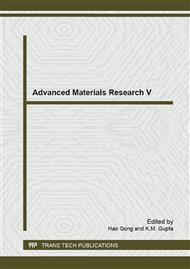[1]
T. Maruyama and T. Morishita, Copper nitride and tin nitride thin films for write-once optical recording media, Appl Phys Lett. 69 (1996) 890.
DOI: 10.1063/1.117978
Google Scholar
[2]
L. -K. A. and S. H., Investigation on the production of copper nitride (copper azide) thin films and their nanostructures, Journal of Theoretical and Applied Physics. 7 (2013) 2.
Google Scholar
[3]
D.M. Borsa and D.O. Boerma, Growth, structural and optical properties of Cu3N films, Surf Sci. 548 (2004) 95-105.
DOI: 10.1016/j.susc.2003.10.053
Google Scholar
[4]
M. -A.M. G., M. -R. A. and T. N., Ab initio total energy calculations of copper nitride: the effect of lattice parameters and Cu content in the electronic properties, SOLID STATE SCIENCES. 6 (2004).
DOI: 10.1016/j.solidstatesciences.2003.10.014
Google Scholar
[5]
J.F. Pierson, Structure and properties of copper nitride films formed by reactive magnetron sputtering, Vacuum. 66 (2002) 59-64.
DOI: 10.1016/s0042-207x(01)00425-0
Google Scholar
[6]
X. a. Li, Q. Bai, J. Yang, Y. Li, L. Wang, H. Wang, S. Ren, S. Liu and W. Huang, Effect of N2-gas flow rates on the structures and properties of copper nitride films prepared by reactive DC magnetron sputtering, Vacuum. 89 (2013) 78-81.
DOI: 10.1016/j.vacuum.2011.10.020
Google Scholar
[7]
G.H. Yue, P.X. Yan, J.Z. Liu, M.X. Wang, M. Li and X.M. Yuan, Copper nitride thin film prepared by reactive radio-frequency magnetron sputtering, J Appl Phys. 98 (2005) 103506.
DOI: 10.1063/1.2132507
Google Scholar
[8]
X.M. Yuan, P.X. Yan and J.Z. Liu, Preparation and characterization of copper nitride films at various nitrogen contents by reactive radio-frequency magnetron sputtering, Mater Lett. 60 (2006) 1809-1812.
DOI: 10.1016/j.matlet.2005.12.028
Google Scholar
[9]
J. Xiao, Y. Li and A. Jiang, Structure, Optical Property and Thermal Stability of Copper Nitride Films Prepared by Reactive Radio Frequency Magnetron Sputtering, J Mater Sci Technol. 27 (2011) 403-407.
DOI: 10.1016/s1005-0302(11)60082-0
Google Scholar
[10]
S. Cho, Effect of substrate temperature on the properties of copper nitride thin films deposited by reactive magnetron sputtering, Current Applied Physics. 12 (2012) S44-S47.
DOI: 10.1016/j.cap.2012.05.033
Google Scholar
[11]
G. Zhang, P. Yan, Z. Wu, J. Wang and J. Chen, The effect of hydrogen on copper nitride thin films deposited by magnetron sputtering, Appl Surf Sci. 254 (2008) 5012-5015.
DOI: 10.1016/j.apsusc.2008.01.156
Google Scholar
[12]
L.X. A., Y.J. P., L.Y. T., W.L. X. and W. H.Y., Study on copper nitride thin films prepared by reactive DC magnetron sputtering, Functional and Electronic Materials. 687 (2011) 706.
DOI: 10.4028/www.scientific.net/msf.687.706
Google Scholar
[13]
C. Gallardo-Vega and W. de la Cruz, Study of the structure and electrical properties of the copper nitride thin films deposited by pulsed laser deposition, Appl Surf Sci. 252 (2006) 8001-8004.
DOI: 10.1016/j.apsusc.2005.10.007
Google Scholar
[14]
T. Ishikawa, M. Masuda and Y. Hayashi, Hydrogen Implantation Effects on the Electrical and Optical Properties of Metal Nitride Thin Films, Materials Transactions. 43 (2002).
DOI: 10.2320/matertrans.43.1138
Google Scholar
[15]
T. J, G. R and V. A, Optical Properties and Electronic Structure of Amorphous Germanium, physica status solidi (b). 15 (1966) 27-37.
Google Scholar


